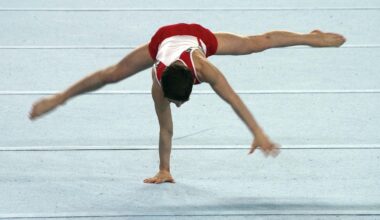Building Social Connections Through Adaptive Sports for Seniors
As we age, maintaining social connections becomes crucial for emotional well-being and overall health. Engaging in adaptive sports offers a unique platform for seniors to forge friendships within their communities. Participating in group activities such as wheelchair basketball or adaptive swimming not only provides physical exercise but also fosters teamwork and camaraderie among participants. These connections can significantly relieve feelings of isolation and loneliness, which are common among older adults. Moreover, this ability to interact with peers who share similar interests creates a supportive network that encourages individuals to stay active. Strengthening these bonds through adaptive sports can lead to improved mental health outcomes, ranging from decreased anxiety to enhanced mood stability. Seniors who regularly engage in adaptive sports report a greater sense of belonging and an improved quality of life. Thus, by embracing adaptive sports, seniors can cultivate meaningful relationships that contribute positively to their physical and mental health. Ultimately, the social connections made in the realm of adaptive sports empower seniors to lead fulfilling and enriched lives.
Adaptive sports provide a platform where seniors can not only get fit but also enhance their social skills. This engagement is vital for maintaining cognitive functions, as social interactions produce positive neurological effects. In structured sports settings, seniors collaborate, compete, and learn from one another, creating bonds that extend beyond the playing field. For instance, a senior who participates in adaptive cycling may meet people with similar interests, leading to lasting friendships. These connections often extend into shared outings, like group dinners or additional activities outside of sports. Furthermore, programs centered around adaptive sports are frequently tailored to different skill levels and interests, allowing for a diverse range of participation. This inclusivity ensures that everyone feels welcomed and valued, regardless of their athletic abilities. The shared experiences in adaptive sports can significantly boost self-esteem and confidence Among participants. It is not just about the sport but also about nurturing relationships and building a supportive community. Joining local adaptive sports teams can lead to lifelong bonds and memorable experiences that enrich seniors’ lives.
The Physical and Mental Benefits of Adaptive Sports
Beyond establishing social connections, adaptive sports offer many physical benefits that significantly impact seniors’ health. Regular participation in these activities helps maintain motor skills, strengthens muscles, and improves cardiovascular health. Sports such as adaptive rowing or sit volleyball challenge seniors physically while providing a sense of achievement and purpose. Engaging in physical activities also releases endorphins, which reduce stress and promote feelings of happiness. Parents of older adults participating in adaptive sports often notice significant enhancements in their mood and energy levels. These improvements can lead to more confidence in social settings, creating a positive feedback loop that encourages further engagement. Additionally, adaptive sports serve as an excellent platform for promoting healthier lifestyles, including the importance of nutrition and fitness among seniors. Resourceful local organizations often provide educational sessions alongside sports training, ensuring that seniors understand the overall health benefits of staying active. Thus, combining physical activity with social engagement leads to profound transformations in both physical health and emotional well-being for seniors.
Incorporating adaptive sports into seniors’ routines creates opportunities for learning new skills that promote personal growth. New experiences tend to stimulate cognitive functions, thus reducing the risk of cognitive decline as one ages. Learning to play a new sport or mastering adaptive techniques fosters a sense of accomplishment and encourages seniors to engage more fully in their communities. Classes and teams often cater to all experience levels, making it easier for seniors to participate without fear of judgment. To further facilitate engagement, organizations also offer incentives, including workshops or community events that integrate sports and social gatherings. Additionally, seniors can find friends and family members who feel encouraged by their involvement and join alongside them, creating more inclusive environments. These shared experiences within adaptive sports can transform the social landscape for seniors by illustrating that age should not constrict mobility or social engagement. As they continuously adapt to new challenges, seniors develop resilience and adaptability that can be beneficial in all areas of life, proving that adaptive sports are not just about competition but also about growth.
Promoting Community Involvement through Adaptive Sports
Local communities play a vital role in supporting adaptive sports programs for seniors. Many cities and towns are recognizing the importance of inclusivity and are working hard to create facilities and programs that cater to the needs of seniors. Sports organizations, community centers, and non-profits often collaborate to provide adaptive sports opportunities. Initiatives like these not only offer seniors a chance to participate but also encourage families and friends to engage, further enriching the community fabric. Hosting adaptive sports events can also mobilize the community, bringing together various stakeholders to showcase talent and community spirit. Engaging volunteers for training or mentorship can further strengthen the ties between generations, as younger participants learn from older, seasoned athletes. Communities that invest in adaptive sports often experience a cultural shift towards inclusivity, demonstrating that older adults have much to offer. Additionally, these programs foster a sense of pride and belonging among seniors, showcasing them as integral parts of the community. By prioritizing adaptive sports, communities empower their elderly population to thrive through social interactions, physical health, and enriched community involvement.
To fully embrace adaptive sports, it is essential to invest in proper resources, including facilities, equipment, and trained staff. Local governments, nonprofits, and health organizations must collaborate to develop programs that address the diverse needs of seniors. Properly equipped adaptive sports facilities enable seamless access for older adults, ensuring that participation is both safe and enjoyable. Furthermore, training staff in adaptive techniques fosters an encouraging environment for senior athletes, allowing them to feel confident in their abilities. Adequate equipment tailored for seniors, such as specialized wheelchairs or sports gear, is also crucial to ensure participation is feasible and fun. In addition to supporting physical activity, these resources serve as catalysts for community spirit. When seniors can comfortably access adaptive sports programs, they are more likely to participate regularly and form connections with others. Moreover, families and caregivers who observe these changes can also foster involvement, leading to a cycle of ongoing engagement. Governments and organizations that prioritize adaptive sports set a precedent for other communities, paving the way for a brighter, healthier future where all seniors can thrive.
The Future of Adaptive Sports for Seniors
As society continues to recognize the essential role of physical health for seniors, the future of adaptive sports looks promising. With the rise of technology and innovations in health, more tailored programs will emerge to cater specifically to the unique needs of older adults. Smart devices and wearables can track progress and motivate seniors to set new fitness goals. Additionally, online platforms may enhance social connections through virtual training sessions or support groups, allowing for broader participation. The importance of adaptive sports will likely grow, with increased awareness of the benefits behavioral health can provide. As more investment flows into these programs, seniors will find themselves at the heart of active, engaging communities. The message that age should not define activity levels will resonate significantly, encouraging higher participation rates in adaptive programs. As adaptive sports evolve with society’s needs, they will continue to empower seniors with both physical and emotional resilience. Memories created through participation will become stories shared across generations, building lasting legacies of strength, friendship, and community.
In conclusion, adaptive sports represent a powerful avenue for seniors to build social connections while promoting their physical and mental health. The primary benefits are twofold: fostering community and encouraging healthier lifestyle choices. Seniors often gain increased confidence and improved emotional well-being through participation in a variety of sports offered by local organizations. These programs allow older adults to engage with their peers, thereby reducing feelings of isolation that can often accompany aging. Moreover, they offer opportunities for learning, personal growth, and new friendships that can enhance overall life satisfaction. As communities invest in adaptive sports initiatives, they promote inclusivity and diversity, celebrating the vibrant contributions seniors can make. Their connections through sports transcend social barriers, creating spaces where all are welcome. The transformation observed when seniors engage in adaptive sports showcases the incredible potential for bonding, resilience, and health. Ultimately, embracing adaptive sports is an invitation to seniors to make lifelong memories while contributing to a more active, inclusive society. The journey through adaptive sports can lead to remarkable outcomes that enhance their quality of life.


